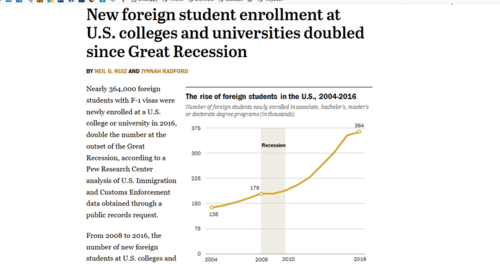Money-grubbing American colleges and universities like foreign students with fat checkbooks, so we probably shouldn’t be surprised at their numbers growing rather sharply.
What’s really scandalous is that the growth of foreign students is substantially higher at public universities — those are the institutions supported by residents’ taxes.:
![]()
California has been one of the worst offenders of opening wide its university doors to foreign students who conveniently pay full freight, unlike the state kids that the institution is supposed to serve. In 2016, the state auditor found that the universities lowered standards for non-residents so they could be admitted and pay maximum tuition. Such policies show up in changing demographics, like at the very desirable UC Berkeley, state residents made up only 67.6 percent of the admitted class in 2016 — meaning a whopping 32.4 percent of the admitted freshmen a year ago were not Californians.
The chart below is a couple years old, but it shows the trend of fewer state residents being served by their university.
![]()
Here’s the Pew memo:
New foreign student enrollment at U.S. colleges and universities doubled since Great Recession, Pew Research, November 20, 2017![]()
Nearly 364,000 foreign students with F-1 visas were newly enrolled at a U.S. college or university in 2016, double the number at the outset of the Great Recession, according to a Pew Research Center analysis of U.S. Immigration and Customs Enforcement data obtained through a public records request.
From 2008 to 2016, the number of new foreign students at U.S. colleges and universities increased 104% – far outpacing overall college enrollment growth, which was 3.4% during the same period, according to U.S. Census Bureau data. The increase was most pronounced at public colleges and universities, which faced budget cuts during the Great Recession and began to rely more heavily on tuition from foreign students.
In the years immediately preceding the Great Recession, growth in the number of new foreign students was more modest, increasing by 20% from 2004 to 2007, but still outpaced overall U.S. enrollment, which rose 7.2% over the same period.
Below are some key facts about foreign students studying in the United States. You can also explore the demographic characteristics of international students who pursued associate, bachelor’s, master’s and doctorate degrees from 2004 to 2016 with our new foreign student fact sheet.
About this analysis
Since the Great Recession, the number of new foreign students enrolled at public colleges and universities has grown faster than at private schools. Enrollments among new foreign students at public higher education institutions grew 107% from 2008 (100,956 students) to 2016 (209,217 students). By comparison, private schools experienced a 98% increase in new foreign students, with enrollment growing from 72,953 in 2008 to 144,697 in 2016.
During this time, overall enrollment declined by less than 1% at public schools and increased 22% at private schools.
(Continues)
















